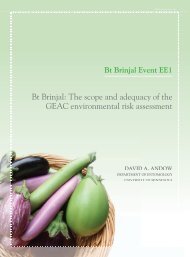English - pdf - 2145 Kb - Biosafety Information Centre
English - pdf - 2145 Kb - Biosafety Information Centre
English - pdf - 2145 Kb - Biosafety Information Centre
- No tags were found...
You also want an ePaper? Increase the reach of your titles
YUMPU automatically turns print PDFs into web optimized ePapers that Google loves.
Are Bioplastics Toxic?One of the reasons that campaigners against toxic chemicalsare actively encouraging the development of the bioplasticsector is that it is possible to invent new polymers from starchand sugar that break down more easily in the environment orhuman body without toxic byproducts. However, as chemistsand synthetic biologists get better at creating chemicalsidentical to petroleum-derived building blocks, we arebeginning to see the same old toxic chemicals produced from adifferent (plant-based) source of carbon. Solvay’sbio-based PVC is a clear example. PVC hascome under sustained attack fromenvironmental health campaigners for itsuse of phthalates, a hormone-disruptingplasticizer, and for the production ofhighly toxic dioxins in the making,recycling and disposal of PVC. Likepetroleum based PVC, producing biobasedPVC still requires chlorine inthe production. As one research groupcommissioned by the EuropeanBioplastics Association was forced toadmit, “The use of bio-based ethylene istherefore unlikely to reduce the environmentalimpact of PVC with respect to its toxicity potential.” 316Are Bioplastics Sourced Sustainably?If you search the Internet for clues about the origin ofbioplastics, you could be forgiven for thinking that today’splastics industry has become a market gardening enterprise.There’s ADM’s Mirel, for example, a “bioplastic” made fromcorn or cane sugar, yet whose website sports photos of pondgrasses. Or Sphere Inc., Europe’s leading biofilm producerwhose homepage is adorned with tulips even though theirplastics are made from potatoes. Sorona, DuPont’s flagshipbioplastic, is promoted by images of grassy hillsides, whileCargill’s “Natureworks” website displays a montage of treeleaves. In truth, both Natureworks and Sorona derive mainlyfrom industrial genetically modified corn drenched inpesticides and in the case of Sorona, transformed by vats ofsynthetic organisms – no tree leaves or grass in sight. Cornbasedbioplastics raise the same concerns as first generationbiofuels in terms of competing with food.If it isunacceptable to turnfood into fuel at a time ofextreme hunger, it should bedoubly unacceptable toturn food into plasticbags.According to Bob Findlen of the Metabolix/ADM’s jointventure, bioplastic company Telles, “If the bioplastics industrygrows to be 10% of the traditional plastics industry, thenaround 100 billion pounds of starch will be necessary, andthere is no question that that will have an effect onagricultural commodities.” 317If it is unacceptable to turn food into fuel at a time of extremehunger, it should be doubly unacceptable to turn food intoplastic bags.As with biofuels, bioplastics manufacturers areattempting to move out of the firing line in thefood vs. fuel battlefield by shiftingfeedstocks. Brazilian cane sugar isparticularly in their sights. DowChemical, the world’s largestpolyethylene producer, has partneredwith Brazilian sugar giant Crystalsevand in 2011 will start producingsugarcane-derived polyethylene (themost widely used of all plastics) from amanufacturing plant with a capacity of317,000 tonnes per year. 318 The plant willconsume 7.2 million tonnes of sugarcane peryear requiring at least 1000 square km of land. 319In October 2010 Brazil’s largest petrochemicals firm,Braskem, opened a $278 million factory designed to producean annual 181,000 tonnes of polyethylene from sugarcaneethanol. Braskem has already secured contracts to provideproducts to Johnson & Johnson, Proctor & Gamble,cosmetics company Shiseido and the Toyota Group. 320Meanwhile Coca-Cola is making one third of its new socalled“Plant Bottle” out of biobased PET from Braziliansugarcane – a move that received the enthusiastic endorsementof WWF World Wide Fund For Nature, whose CEO declaredit “yet another great example of their leadership onenvironmental issues.” 321As already noted, Brazilian sugarcane plantations haveattracted fierce criticism for their social and environmentalimpact. Meanwhile even plastics made from the humblepotato such as Stanelco’s ‘Bioplast’ also raise productionconcerns. U.S.-based watchdog Environmental WorkingGroup regards potatoes as having one of the highest pesticideresidue limits on any food. 322The New Biomassters 53











